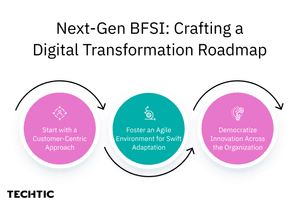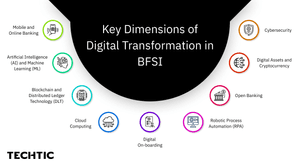Digital Transformation Roadmap for BFSI – It’s a Journey
Sector: Digital Product
Author: Nisarg Mehta
Date Published: 09/12/2023

Contents
The COVID-19 pandemic has significantly accelerated digital transformation across various industries, including the banking and finance sectors. This phenomenon encompasses older generations, such as baby boomers and seniors, embracing digital banking services and consumers becoming more adept at using QR codes for various transactions.
Notably, 97% of key decision-makers in enterprises acknowledge that the pandemic played a pivotal role in expediting their digital transformation efforts.
However, it’s essential to recognize that implementing technological changes in a business is not a universally applicable solution, and obtaining support from leadership is often a complex and non-automatic process.
Once the leadership is onboard, the digital transformation roadmap begins. We’ve seen companies in the BFSI (Banking, financial services and insurance) industry adopting the digital revolution. For example, Bank of America’s Erica virtual assistant implementation that helps customers with tasks such as setting financial goals, tracking spending, and finding investment opportunities.
Looking at most of the successful digital transformation initiatives in the BFSI segment, one thing is clear. Banking and finance digital transformation begins at the customer level.
Digital Transformation Roadmap for Next-Gen BFSI Companies

Despite the level of technology implementation you’re planning as a banking and finance institution, the approach remains the same. Here are the three steps to digital transformation for BFSI:
1. Start with a Customer-Centric Approach
Many companies often focus on improving internal processes and reducing costs through the adoption of the latest technology. However, it’s advisable to begin by prioritizing the customer experience. Encourage your company’s leadership to measure customer satisfaction and gain a deep understanding of their pain points. Every business decision should revolve around customer insights derived from robust data analysis.
2. Foster an Agile Environment for Swift Adaptation
Innovative organizations must cultivate a culture that values rapid testing and continuous learning. Building an environment where you can gather real-time customer feedback and adapt swiftly is crucial for shaping your forward-looking strategy.
3. Democratize Innovation Across the Organization
Embed innovation into the very fabric of your company, and avoid confining it to a single isolated team. This means actively involving employees at all levels within your organization. Seek creative ideas and input from individuals with diverse backgrounds, experiences, and locations. By engaging the full spectrum of your workforce, you not only harness a wide range of skills and digital expertise but also tap into a potential wellspring of innovative solutions.
Different Aspects of Digital Transformation in BFSI

The banking and finance landscape has recently undergone a significant transformation, driven by various technological advancements and changing customer expectations. Here are some key developments BFSI is experiencing in the United States:
1. Mobile and Online Banking
The proliferation of mobile and online banking has revolutionized how customers engage with financial institutions.
Banks have streamlined access to their services through user-friendly digital platforms, empowering customers to manage accounts, conduct transactions, and access customer support effortlessly via mobile devices.
This digital shift not only enhances customer convenience but also bolsters security measures, ensuring a safer banking experience.
2. Artificial Intelligence (AI) and Machine Learning (ML)
AI and ML technologies have become pivotal in the digitization of the banking industry. Banks leverage these tools to automate repetitive tasks, including data entry and account reconciliation, leading to improved operational efficiency and reduced errors.
Predictive analytics powered by AI helps banks make informed decisions. Furthermore, Natural Language Processing (NLP) is employed to enhance chatbot interactions and provide personalized financial guidance, thereby elevating the overall customer service experience.
3. Blockchain and Distributed Ledger Technology (DLT)
Banks in the United States are increasingly adopting Blockchain and DLT to secure financial transactions and introduce innovative services such as digital identities and smart contracts.
These decentralized and tamper-resistant technologies enhance transaction security and transparency, fostering trust within the financial ecosystem. They also lay the foundation for emerging products like digital assets and cryptocurrencies, facilitating payments and financial transactions.
4. Cloud Computing
Cloud computing plays a pivotal role in reshaping the digital landscape of US banks. It enables efficient storage, processing of vast data sets, and the seamless operation of various applications. This adoption leads to cost reduction, scalability enhancement, and overall IT system efficiency improvement.
Cloud-based solutions empower banks with remote data access, fostering collaboration, agility, and adaptability to rapidly changing market dynamics and customer demands.
For instance, in 2021, Wells Fargo partnered with Google for cloud computing to improve the scalability and efficiency of its IT infrastructure. The bank is also using data analytics to improve fraud detection and risk management.
5. Digital On-boarding
Digital onboarding practices employ technology to facilitate a quicker, more convenient, and secure process for customers when establishing relationships with financial institutions. This includes features like e-signatures, real-time account verification, and remote identity validation, ensuring a smoother account setup experience.
Integration with Customer Relationship Management (CRM) and risk management systems enhances customer journeys while reducing operational costs. Neo banks and other FinTech startups are already doing it; it’s time for legacy banking and finance organizations to adopt it.
6. Robotic Process Automation (RPA)
RPA is rapidly revolutionising banking operations in the United States. By automating mundane tasks, RPA reduces error rates, improves efficiency, and ensures data consistency and accuracy. This technology streamlines operations, enhances customer service, reduces costs, and enables banks to maintain competitiveness and customer-centricity.
7. Open Banking
Open Banking initiatives allow financial institutions in the United States to securely share customer data with authorized third-party providers through APIs. This empowers customers with a broader range of services, including account aggregation and financial planning.
The increased transparency and accessibility of Open Banking contribute to an improved customer experience and stimulate innovation within the financial sector.
8. Digital Assets and Cryptocurrency
US banks are exploring the use of digital assets and cryptocurrencies to diversify revenue streams, tap into new markets, and engage customers more effectively.
These technologies offer opportunities to enhance transaction efficiency, security, and speed while reducing traditional banking system costs. Banks are keen to participate in the growing digital economy and manage associated risks effectively.
9. Cybersecurity
Ensuring the security of customer data is paramount for banking and financial institutions. They employ advanced cybersecurity measures such as multi-factor authentication, encryption, biometrics (e.g., fingerprints, facial recognition, voice recognition), and behavioural analytics to safeguard against fraud and protect customer information. These investments in cybersecurity uphold trust and confidence in the banking sector.
The Key is to Ensure Efficiency while Managing Risk
It’s essential to recognize that digital transformation plays a pivotal role in improving business operations and making life easier and better for customers and employees.
Efforts to boost efficiency should focus on removing barriers to success and establishing effective teams and governance structures aligned with the company’s objectives. This can involve organizing teams with clear decision-making authority, implementing outcome-driven processes, aligning metrics with strategic goals, and setting guidelines for resource allocation.
Operational efficiency also contributes to effective risk management. A well-optimized operation is better positioned to identify and address potential risks that could disrupt the business. Prioritizing risk management is crucial for organisations, as it ensures operational excellence and enhances the overall experience for clients and employees.
Latest Tech Insights!
Join our newsletter for the latest updates, tips, and trends.







